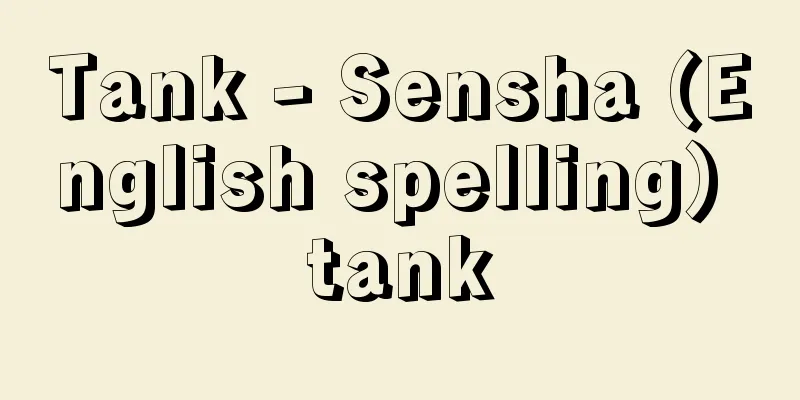Tank - Sensha (English spelling) tank

|
An offensive weapon that combines striking power, defensive power, and mobility. In general, it often refers to a wide range of tracked combat vehicles, including armored cars and self-propelled guns, but in the narrow sense, it refers to a fully tracked (caterpillar) vehicle equipped with a powerful gun that mainly fires directly in a turret that can rotate all around, and protected entirely by strong armor plates. [Akira Takeuchi] ClassificationBefore World War II, tanks were classified according to their weight into light, medium, and heavy tanks, but the standards varied widely depending on the era and country. Currently, tanks are classified according to their purpose, such as reconnaissance tanks, main battle tanks, and support tanks. A self-propelled gun is similar to a tank. Originally, it was a completely different vehicle, simply a gun mounted on a tractor for ease of movement, but with the addition of armor and improved mobility, the difference between the two has become smaller mechanically, apart from the way they are used. [Akira Takeuchi] HistoryThe history of the tank can be traced back to the Chariot (ancient tank) around 2000 BC, but it is generally considered to have originated from Little Willie, a prototype made in England during World War I. The latter half of World War I was a complete stalemate of trench warfare, so the tank was conceived as a surprise weapon that could withstand enemy machine gun bullets and break through trenches freely in order to break the deadlock. Little Willie was an unarmed prototype, but Big Willie, the prototype of a combat tank equipped with one 57mm cannon on each side of the body, was completed and the first test drive was conducted on January 16, 1916. These developments were carried out by members of the Landships Committee, which was established with the support of Winston Churchill, who was the First Lord of the Admiralty at the time, but to maintain secrecy, they were treated as "tanks" to carry water to front-line troops ordered by Russia. This is the origin of the word tank, which is still used today. The mass-produced Tank Mk. 1, based on Big Willie, was first deployed in the Battle of the Somme on September 15, 1916, but only 49 tanks were used, and many of them broke down, so although it shocked the German army to some extent, it ended up being a failure in terms of military tactics. This led to some criticism of tanks, but in the Battle of Cambrai on November 20, 1917, 474 tanks were deployed in a narrow front and were very successful in breaking through the lines, securing their position. Completely separate from the British plan, tank development was also carried out in France, led by General Jean-Baptiste Eugène Estienne (1860-1936), and 400 tanks were ordered from Schneider (now Schneider Electric) in February 1916, but because they were not used in combat until April 1917, the world's accepted theory is that Britain invented the tank. Meanwhile, in the Soviet Union, the single-track "rough terrain vehicle," which pre-revolutionary Imperial Russia began designing in August 1914 and completed testing in May 1915, was considered to be the world's first tank. During World War I, British heavy tanks from the Model I to Model VIII, medium tanks from the Model A to D, French Schneider tanks, St. Chamond tanks, Renault FT light tanks, Italian Fiat 2000, and German A7V were produced, but of these, it was the French Renault FT that became the basis for postwar tank development. While most other tanks had a structure similar to that of self-propelled guns with only limited arcs of fire, the Renault FT had a turret with an all-round arc of fire on the centerline of the vehicle and used a shock absorber mechanism for its running gear, making it fully equipped with the qualities to become the ancestor of modern tanks. For about 20 years after the end of World War I until World War II, tank technology was growing as the level of related industries improved, and various attempts were made in various countries, but it was during World War II that groundbreaking progress and development was seen. The blitzkrieg waged by the German army at the beginning of World War II used tanks as a military shock force, which brought about a revolution in the idea of tanks as a military force, which had been based mainly on supporting infantry. As the war progressed, the idea that tanks were the primary means of countering tanks also grew stronger, and as a result, while at the start of the war standard main battle tanks were 10-20 tons and equipped with 37-57 mm guns, such as the Type 97 medium tank (Japan), Panzer III (Germany), and M2 light tank (USA), by the end of the war, standard tanks were 30-45 tons and equipped with 75-90 mm guns, such as the Panther (Germany), M4 medium tank (USA), and T34 medium tank (Soviet Union), and among them were powerful heavy tanks such as the German Tiger II (69 tons, equipped with a 71-caliber 88 mm gun) and the Soviet ИС(Yes) II (46 tons, equipped with a 43-caliber 122 mm gun). The end of World War II also temporarily slowed down the development of tanks. In particular, with the emergence of nuclear weapons, there were strong arguments that tanks were useless, but the results of various experiments showed the exact opposite: that armored vehicles were effective against nuclear weapons, and after the war each country began to develop new advanced vehicles one after another. Modern tanks have been dramatically improved in terms of attack, defense, and mobility compared to previous tanks. In terms of attack, not only have the guns and ammunition developed, but the fire control system has also made great strides to improve accuracy, and the latest electronics technology has been adopted to ensure that the first shot hits the target. In terms of defense, in addition to conventional bulletproof steel and aluminum alloys, special composite armor has been developed that combines ceramics and titanium alloys, which is particularly effective against shaped charge warheads used in anti-tank missiles and rockets. In addition, since it has become necessary to operate in nuclear-contaminated areas, it has become essential to install a CBR protection device that combines a special filter and blower to increase internal pressure and prevent harmful outside air from entering the vehicle. On the other hand, in terms of mobility, lightweight, high-output diesel engines or gas turbines are used, which, combined with a highly efficient steering and transmission, give the tank instantaneous speed and power. Representative examples include the American M1 series, the Russian T-80 series, the German Leopard 2 series, the British Challenger series, the French Leclerc, and the Japanese Type 90 tank, all of which have a 120-125 mm main gun and weigh around 50-60 tons. In order to achieve a high muzzle velocity, smoothbore guns firing wing-stabilized bullets became the norm, replacing the rifled barrels that had been used up until then. [Akira Takeuchi] structureA standard tank consists of a body and a turret, and is divided into three sections: the driver's compartment, fighting compartment, and engine room. The driver's compartment is located at the front of the vehicle and seats a single driver. Tanks before World War II often had a gunner's seat next to the driver to operate the machine gun at the front of the vehicle. The fighting compartment, which is centered around the turret, seats three people: the tank commander, gunner, and loader. The tank commander commands the vehicle, the gunner fires the main gun and turret gun, and the loader loads ammunition. Some tanks do not require a loader due to the adoption of an automatic loading device. The main gun is mounted in the turret with a recoil mechanism via a trunnion (a protrusion for mounting the gun barrel) so that any elevation or depression angle can be achieved. The recoil mechanism is a device that absorbs the recoil of the gun when it is fired and returns the recoiled gun to its home position, but due to the internal volume of the turret, the recoil distance of a tank gun is smaller than that of a normal gun. The direction of the gun is changed by rotating the entire turret using a gear mechanism, which is mainly operated electrically or hydraulically, usually in conjunction with a manual mechanism. The engine room at the rear houses the engine and the steering gear, which transmits power to the drive wheels through a final reduction gear (a gear device that reduces the power from the steering gear and transmits it to the drive wheels), driving the tracks. Unlike wheeled vehicles, tracked vehicles change direction by changing the speed of the left and right tracks, and there are many types of steering gear. [Akira Takeuchi] "Tanks" by Kotaro Katogawa (1977, Keibunsha)" ▽ "Japanese Tanks" by Otomi Hara, Denji Sakaemori, and Akira Takeuchi (1978, Shuppan Kyodosha)" ▽ "Modern Combat Vehicles" by R.M. Ogorkiewicz, translated by Hayashi Iwao (1983, Gendai Kogakusha)" ▽ "Tank Technology" by Hayashi Iwao (1992, Technical Education Research Association)" ▽ "Tanks and Generals: The Heart of Army Weapons Technology" by Domon Shuhei (1996, Kojinsha)" ▽ "Tanks of the World" by Peter Chamberlain and Chris Ellis (1997, Dai Nippon Kaiga)" ▽ "Tank Mechanisms Illustrated Encyclopedia" by Ueda Makoto (1997, Grand Prix Publishing) ▽ "Tiger Tanks" by Walter J. Spielberger, translated by Tsukube Shigeaki (1998, Dai Nippon Kaiga)" ▽ "Panther Tank" by Walter J. Spielberger, translated by Takahashi Yoshifumi (1999, Dai Nippon Kaiga)" ▽ "History of the Development of German Tanks" by Saiki Nobuo (1999, Kojinsha)" ▽ "Catalogue of Main Battle Tanks of the World" edited by the Japan Weapons Research Association (2000, Ariadne Kikaku)" ▽ "Modern Tank Technology" edited by the Japan Weapons Research Association, planned and supervised by Kiyotani Shinichi (2001, Ariadne Kikaku)" [References] | | | |A tank of the Japan Ground Self-Defense Force. Overall length: 9.8m, overall width: 3.4m, overall height: 2.3m, total weight: 50t, maximum speed: 70km/h. 120mm smoothbore gun, 12.7mm heavy machine gun M2, Type 74 vehicle-mounted 7.62mm machine gun ©Shogakukan "> Type 90 tank A tank of the Japan Ground Self-Defense Force. Overall length: 9.4m, overall width: 3.2m, overall height: 2.3m, total weight: 44t, maximum speed: 70km/h. 120mm smoothbore gun, 12.7mm heavy machine gun M2, Type 74 vehicle-mounted 7.62mm machine gun ©Shogakukan "> Type 10 tank The diagram shows an example of the structure of the Leopard 2, which was independently developed by the former West Germany in the 1970s. With its powerful 120mm gun, composite armor, and high-powered engine, it was called the most balanced MBT (main battle tank). Length 9.61m, width 3.70m, combat weight 55.2t, power plant MTU-MB873 diesel engine, maximum speed 72km/h, range 550km, crew 4, armament: 120mm smoothbore gun (carrying 42 shells), 2 x MG3 machine guns (1) 120mm L44 smoothbore gun (2) Shell rack (3) Steering wheel (4) Driver's seat (5) Fire extinguishing cylinder (6) Gunner's seat (7) Commander's seat (8) Main hydraulic system (9) Fuel tank (10) Battery (11) Cooling fan (12) 77mm quadruple smoke grenade launcher (both sides) (13) Wind sensor (14) Computer and radio (15) Commander's cupola (observation tower) (16) Loader's cupola (17) Commander's panoramic sight (18) 2 x 7.62mm MG3 machine guns (19) Gunner's sighting device (20) Swing arm (a device that supports the rollers and absorbs unevenness in the ground) © Toshihisa Watanabe "> Tank Structure Source: Shogakukan Encyclopedia Nipponica About Encyclopedia Nipponica Information | Legend |
|
打撃力、防御力、機動力をあわせ備えた攻撃的兵器。一般的には装甲車、自走砲なども含め、広く装軌式戦闘車両をさす場合も多いが、狭義には全周旋回可能な砲塔内に直接射撃を主とした強力な火砲を装備し、全体を強固な装甲板で防護した全装軌式(キャタピラー式)車両をいう。 [竹内 昭] 分類第二次世界大戦以前は重量により、軽戦車、中戦車、重戦車などに区分するのが慣例であったが、時代あるいは国によりその基準には大きな差があった。現在ではその用途により、偵察戦車、主力戦車(主戦闘戦車)、支援戦車というような分類法がとられている。 戦車に近似したものに自走砲がある。これは本来、火砲をトラクター上に搭載して移動の便を図っただけの、戦車とはまったく別のものであるが、装甲防御力の付与、機動力の向上に伴い、その用法は別にして、機構的にはあまり差がなくなってきている。 [竹内 昭] 沿革戦車の歴史をさかのぼれば、紀元前2000年ごろの「チャリオット」(chariot=古代戦車)に至るが、一般的には第一次世界大戦中にイギリスで試作されたリトル・ウィリーをもって始祖としている。第一次世界大戦後期はまったくの塹壕(ざんごう)戦で、全面的に膠着(こうちゃく)状態となったため、この均衡を破ることを目的に、敵の機関銃弾によく耐え、壕を自由に突破できる奇襲兵器として考えられたのが戦車であった。リトル・ウィリーは武装なしの試作車だったが、続いて57ミリメートル砲各1門を車体両側面のスポンソン(はり出し砲門)に装備した実戦型戦車の原型であるビッグ・ウィリーが完成し、1916年1月16日に最初の走行試験が行われた。 これらの開発は、当時海軍大臣の職にあったウィンストン・チャーチルの支持のもとに設立された陸上軍艦委員会Landships Committeeのメンバーによって行われたが、機密保持上、ロシアから発注された前線部隊に水を運ぶ「水槽」(タンク、tank)として取り扱われた。これが戦車(タンク)の語源であり、現在もなお使用されている。 ビッグ・ウィリーを基礎とした量産型のⅠ号型戦車Tank Mk. 1は、1916年9月15日のソンムの戦いに初めて投入されたが、数量がわずか49両であったのに加え、故障車が続出したため、ドイツ軍にある程度のショックを与えたものの用兵的には失敗に終わった。このため、一部に戦車に対する批判の声が大きくなったが、翌1917年11月20日のカンブレー戦においては474両を狭正面に集中投入し陣地突破に大成功を収め、その地位を確保した。 イギリスのこの計画とはまったく別に、フランスにおいても戦車の開発がJ・E・エティエンヌ将軍Jean-Baptiste Eugène Estienne(1860―1936)を中心に行われ、1916年2月には400両がシュナイダー社(現、シュナイダーエレクトリック社)に発注されたが、1917年4月まで実戦に投入されなかったため、戦車の発明国はイギリスであるというのが世界の定説になっている。他方ソ連では、革命前の帝政ロシアが1914年8月に設計を開始し、1915年5月に試験を完了した1履帯(キャタピラー)式の「不整地通過車」を世界最初の戦車として位置づけていた。 第一次世界大戦にはイギリスのⅠ号型からⅧ号型重戦車、A型からD型までの中戦車、フランスのシュナイダー戦車、サン・シャモン戦車、ルノーFT軽戦車、イタリアのフィアット2000型、ドイツのA7Vなどが製作されたが、これらのうち戦後の戦車発達の母体となったのは、フランスのルノーFTであった。ほかの戦車のほとんどが限定射界の火砲しかもたぬ自走砲に近い構造であったのに対し、ルノーFTは車体中心線上に全周射界の砲塔を有し、走行装置に緩衝機構を採用するなど、近代戦車の始祖としての資質を十分に備えていたのである。 第一次世界大戦終結後、第二次世界大戦までの約20年間は、関連産業のレベルアップとともに戦車の技術的成長期にあたり各国で各種の試みが行われたが、画期的な進歩発達をみたのは第二次世界大戦においてである。第二次世界大戦初頭にドイツ軍が演じた電撃戦は、戦車を軍の衝撃力として用いるもので、それまでの歩兵の支援を主体とする戦車用兵思想に革命をもたらすものであった。また戦争の進展に伴い戦車への対抗手段には戦車が第一であるという考えも強まり、その結果、開戦時には九七式中戦車(日本)、Ⅲ号戦車(ドイツ)、M2軽戦車(アメリカ)などのように重量10~20トン、37~57ミリメートル砲装備が標準であった主力戦車が、大戦末期には、パンター(ドイツ)、M4中戦車(アメリカ)、T34中戦車(ソ連)のように30~45トン、75~90ミリメートル砲装備が標準となり、なかにはドイツのティーガーⅡ型(69トン、71口径88ミリメートル砲装備)、ソ連のИС(イエス)Ⅱ(46トン、43口径122ミリメートル砲装備)などの強力な重戦車も登場した。第二次世界大戦の終結により戦車の開発も一時的にスローダウンした。とくに核兵器の登場に伴い戦車無用論も強くおこったが、各種実験の結果はまったく逆に装甲車両の対核兵器有効性を示すことになり、各国とも戦後型新鋭車両を次々と開発するようになった。 現代の戦車をこれまでの戦車と比較した場合、攻撃力、防御力、機動力のすべてにわたり画期的な向上が図られている。攻撃力については搭載火砲、使用弾薬の発達もさることながら、命中精度を高めるための射撃統制装置が飛躍的に進歩し、最新のエレクトロニクス技術の採用により初弾必中を期している。防御力については、従来の防弾鋼板やアルミ合金に加え、セラミックス、チタン合金などを組み合わせた特殊な複合装甲が開発され、とくに対戦車ミサイル、ロケット弾などに用いられる成形炸薬(さくやく)弾頭に対し有効なものになっている。また核汚染地域などで行動する必要が生じた関係上、特殊フィルターとブロワーを組み合わせ、内圧を高めて有害外気の車内侵入を防ぐ、対CBR防護装置の設置も不可欠の条件となった。一方、機動性については軽量大出力のディーゼルエンジンまたはガスタービンが採用され、高効率の操向変速装置と相まって、瞬発性と高速力を得ている。 代表的な例としてはアメリカのM1系列、ロシアのT-80系列、ドイツのレオパルト2系列、イギリスのチャレンジャー系列、フランスのルクレール、日本の90式戦車などがあり、いずれも120~125ミリメートル級の主砲をもち、重量は50~60トン前後となっている。 主砲は高初速を得るために、これまでのライフル砲身にかわり、翼安定弾を発射する滑腔砲が主流になった。 [竹内 昭] 構造標準的な戦車は車体部と砲塔部からなり、操縦室、戦闘室、機関室の3部分に分かれる。操縦室は車体前部にあり、操縦手1名が座る。第二次世界大戦以前の戦車ではこれに並び車体前方機関銃を操作する銃手席を設けたものが多かった。砲塔を中心とする戦闘室には、戦車長、砲手、装填(そうてん)手の3名が座乗し、戦車長は車両の指揮、砲手は主砲・砲塔銃の射撃、装填手は弾丸の装填を行う。自動装填装置の採用により装填手をなくしたものもある。 主砲は砲塔内に駐退復座機とともに砲耳(砲身を取り付けるための突起部)を介して取り付けられ、任意の俯仰(ふぎょう)角度が得られるようになっている。駐退復座機は射撃の際の砲の反動を吸収するとともに後座した砲を定位置に戻す装置であるが、戦車砲は砲塔内容積の関係から通常の火砲に比較して後座量が小さい。砲の方向変換は歯車装置により砲塔全体を旋回させて行うが、その作動は電気または油圧を主体とし、手動機構を併用するのが普通である。 後部の機関室には、エンジン、変速操向機があり、終減速機(変速操向機からの動力を減速し起動輪に伝える歯車装置)を通して動力を起動輪に伝達し履帯(キャタピラー)を駆動する。装軌車の方向変換は装輪車と違い、左右の履帯の速度を変えることによって行うが、その操向機の方式には多くの種類がある。 [竹内 昭] 『加登川幸太郎著『戦車』(1977・圭文社)』▽『原乙未生・栄森伝治・竹内昭著『日本の戦車』(1978・出版協同社)』▽『R・M・オゴルキーヴィッツ著、林磐男訳『近代の戦闘車両』(1983・現代工学社)』▽『林磐男著『タンクテクノロジー』(1992・技術教育研究会)』▽『土門周平著『戦車と将軍――陸軍兵器テクノロジーの中枢』(1996・光人社)』▽『ピーター・チェンバレン、クリス・エリス著『世界の戦車』(1997・大日本絵画)』▽『上田信著『戦車メカニズム図鑑』(1997・グランプリ出版)』▽『ヴァルター・J・シュピールベルガー著、津久部茂明訳『ティーガー戦車』(1998・大日本絵画)』▽『ヴァルター・J・シュピールベルガー著、高橋慶史訳『パンター戦車』(1999・大日本絵画)』▽『斎木伸生著『ドイツ戦車発達史』(1999・光人社)』▽『日本兵器研究会編『世界の主力戦車カタログ』(2000・アリアドネ企画)』▽『日本兵器研究会編、清谷信一企画・監修『現代戦車のテクノロジー』(2001・アリアドネ企画)』 [参照項目] | | | |陸上自衛隊の戦車。全長約9.8m、全幅約3.4m、全高約2.3m、全備重量約50t、最高速度約70km/h。120mm滑腔砲、12.7mm重機関銃M2、74式車載7.62mm機関銃©Shogakukan"> 90式戦車 陸上自衛隊の戦車。全長約9.4m、全幅約3.2m、全高約2.3m、全備重量約44t、最高速度約70km/h。120mm滑腔砲、12.7mm重機関銃M2、74式車載7.62mm機関銃©Shogakukan"> 10式戦車 図は、1970年代に旧西ドイツが独自開発したレオパルト2の構造例である。強力な120mm砲と複合装甲、高出力エンジンにより、もっともバランスのとれたMBT(主力戦車)とよばれた。全長9.61m、全幅3.70m、戦闘重量55.2t、機関MTU-MB873ディーゼルエンジン、最高時速72km、航続距離550km、乗員4名、武装:120mm滑腔砲(砲弾42発積載)、MG3機関銃×2(1)120mmL44滑腔砲 (2)砲弾ラック (3)ステアリングホイール(ハンドル) (4)操縦手席 (5)消火用ボンベ (6)砲手席 (7)車長席 (8)主油圧装置 (9)燃料タンク (10)バッテリー (11)冷却ファン (12)77mm四連装発煙弾投射器(両側とも) (13)風光センサー (14)コンピュータおよび無線機 (15)車長用キューポラ(展望塔) (16)装填手用キューポラ (17)車長用パノラマ照準装置 (18)7.62mm機関銃MG3×2 (19)砲手用照準装置 (20)スウィングアーム(転輪を支持し、地面の凹凸を吸収する装置)©渡部利久"> 戦車の構造 出典 小学館 日本大百科全書(ニッポニカ)日本大百科全書(ニッポニカ)について 情報 | 凡例 |
<<: Advance loan - Zenshakukin
Recommend
Illiberis pruni (English spelling) Illiberispruni
…[Hiroshi Inoue]. … *Some of the terminology that...
Nobel Prize - Nobel Prize
The prize is awarded annually by four institutions...
Carpenter - Carpenter
...There are three types of palanquins: hand pala...
Talev, D.
… [Literature after World War II] On September 9,...
Melierax metabates
...In Japan, there are four species of birds, fro...
Juàzeiro do Norte (English spelling)
A religious city in the Cariri Valley at the foot ...
binomials
…The starting point for naming plants and animals...
Rudolf Borchardt
German poet, essayist, translator, and cultural h...
Meteorological business - Kishojigyo
A business that observes the weather, issues forec...
Rhino - Rhino
A general term for mammals in the Rhinoceros famil...
Beroe cucumis - Beroe cucumis
A ctenophore of the Cucurbitidae family of the cla...
Katayama Hokkai
A Confucian scholar from the mid-Edo period. Born ...
Malayan Union (English spelling)
…The Malay Peninsula and northwestern Borneo were...
space transportation system
…Spacelab is a nickname that is an abbreviation o...
air-jet loom
...There are some that insert the rods from both ...

![Hiraizumi [town] - Hiraizumi](/upload/images/67cca50593dc0.webp)







